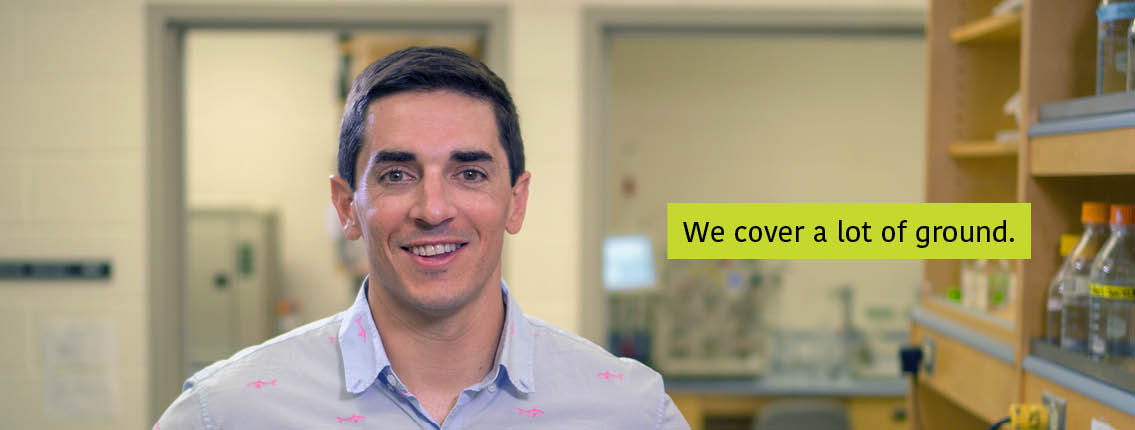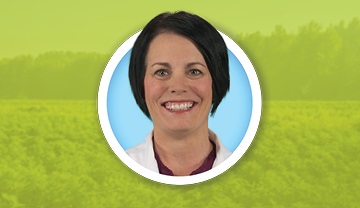
Dr. Christopher Garnham
Research Scientist – Protein Biochemistry
London Research and Development Centre
Why did you become a scientist?
I enjoy solving problems and making discoveries, and I still remember when I made my first big breakthrough during my Ph.D. studies. I realized I was looking at something that no one else had ever seen before. That feeling of discovery was exhilarating and it is something that still drives me to this day.
Meet Dr. Christopher Garnham
Video transcript
*NOTE: This footage was recorded prior to the Government of Canada's physical distancing guidelines. Canadians are encouraged to continue to follow COVID-19 safety guidelines.
[Technological music starts.]
[Chris Garnham walks down a hallway carrying scientific samples. Text appears beneath him with a location icon.]
Text on screen: London, Ontario
Chris Garnham: We think in the future, with the tools that we're developing, it's going to allow us and various producers . . .
[Chris walks through a doorway. Inside a molecular lab, another scientist prepares an experiment.]
. . . to have less food waste, and if we have less food waste, that's going to produce lower costs at the super market.
[A line of shoppers checks out at a grocery store.]
[Cut to Chris Garnham being interviewed in a laboratory. Text appears beneath him.]
Text on screen: Dr. Chris Garnham, Research Scientist – Biochemistry, Agriculture and Agri-Food Canada
Hi, my name's Chris Garnham, and I'm a research scientist at Agriculture Canada.
[Chris analyses data on a computer.]
My field of science is the study of enzymes. An enzyme is just a type of protein.
[Close-up of a microscope view of cells.]
There are tens of thousands of enzymes in every cell within every living organism. So they're little nano-machines that have their own specific function in the cell.
[Chris looks into a microscope.]
And a lot of times these enzymes are responsible for breaking something down into its constituent parts.
[Chris adjusts the microscope. A computer monitor shows a macro view of the sample he's analyzing.]
Some crops can be infected by a fungus. . .
[Grain slides from a farmer's hand into a larger pile of grain. Wheat stalks blow in the wind.]
. . . and that fungus, as it's growing on that crop, will produce small chemicals that are toxic to humans and livestock.
[A scientist pipets liquid into sample containers.]
We found an enzyme that's produced by a fungus that is capable of breaking down some of these toxins.
[Chris and another scientist retrieve a beaker of yellow liquid.]
And so we can then take that enzyme and use it to treat contaminated food and feed . . .
[Chris pipets tiny drops of liquid into a tray.]
. . . using these novel enzymes that will break down those toxins . . .
[Chris stores his samples on a shelf with a dozen other trays.]
. . . and that's going to produce lower prices for the average consumer . . .
[A woman shops in the meat section of a grocery store.]
. . . and it's also going to produce safer food and feed for humans and livestock.
[A farmer's hand scoops animal feed out of a basin.]
[The screen goes white. Text fills it.]
Text on screen: Learn more at agr.gc.ca/fields-of-science. We cover a lot of ground.
[The Canada wordmark appears. The technological music fades out.]
Profile
What was the biggest challenge you ever encountered in your career?
Deciding which areas to focus on when I started my own lab at Agriculture and Agri-Food Canada. My training was more academic and focused on basic science. I branched out and started new lines of research in my own lab, which allowed me to apply the skills I learned during my training to areas that have the potential for more immediate impact.
What is the most common question people ask you about your work?
"What do you do?" It seems like a simple question, but it can be difficult to explain what I do to most people who are not trained as scientists. I enjoy trying to come up with new ways of explaining my research that keeps people engaged and eager to know more.
Who inspired your career or who is your idol?
I've been fortunate to receive excellent mentorship throughout my scientific training. My PhD supervisor at Queen's University, Dr. Peter Davies, gave me a lot of freedom to explore my own ideas. Furthermore, my postdoctoral supervisor at the National Institutes of Health in Maryland, Dr. Antonina Roll-Mecak, taught me how to work hard and be fearless. I have relied heavily on these traits at this early point in my career.
What is your favorite food?
Roast beef dinner with mashed potatoes and gravy, and broccoli with cheese sauce.
Out-of-the box thinking for one of Canada's biggest crops
A walk through any modern grocery store reveals a hopping 4,000‑plus products listing corn as an ingredient. Its versatility is huge, and hundreds of industrial processes use corn as an environmentally friendly component, with it being used in everything from diapers and drywall to antibiotics. So if our corn crop is threatened by naturally occurring toxins called mycotoxins from fungi, we have a problem.
Many fungi produce these toxic chemicals in the crops they infect. Mycotoxins pose a food safety risk, particularly to the livestock that eat them. Mycotoxin contamination presents one of the biggest challenges for crop farmers everywhere, especially those growing corn and wheat.
Agriculture and Agri-Food Canada's (AAFC) London Research and Development Centre is located in the heart of Ontario's corn country. Researchers there see mycotoxin-damaged corn first-hand.
Fortunately, AAFC researcher Dr. Christopher Garnham, a biochemist at the centre, works with a team that also sees a potential opportunity in a recent discovery. They have their eyes on a sustainable solution—one that could reduce the impact of the threat and our use of herbicides.
The approach is based on the ability of certain fungi to produce enzymes that can transform their own toxins into more harmless forms.
"This enzyme may have been overlooked in the past because we just couldn't detect the detoxified product it makes," says Dr. Garnham. "Now, thanks to the latest laboratory equipment we have at the centre, we're able to identify and analyse it."
So what's the big deal about the enzyme? Well, given how widespread the mycotoxin threat is and how difficult it is control, it could be hugely significant.
For corn and wheat, it could mean not having to spray herbicides, or being able to reduce the food safety risk posed by the toxins. All of which would translate into cost savings, better food safety, and less impact on the environment.
Dr. Garnham is screening large numbers of these detoxifying enzymes to identify those that are most effective. Animal feed companies are already working with him on the safety and practicality of adding the enzymes to animal feed, as well as other potential applications—all in the name of greater sustainability.
The First Sixteen Podcast
Episode 005 – Saving nutrients with novel science
Christopher Garnham and his team at AAFC has discovered something very small that could have big impacts in the food and feed industry. Some crops such as corn and wheat can be infected by a fungus that, while growing, produces mycotoxins. Ingestion of mycotoxin-laden food and feed is detrimental to the health livestock and humans. Listen as Christopher Garnham explains the discovery he and his team made of an enzyme that has the potential to mitigating these toxins in Canadian agri-food and agri-feed.
More agriculture and agri-food science

Learn how scientists are researching ways that a cow's genetics and diet can lower methane emissions.

Learn how scientists are working with NASA to improve soil moisture data needed for Canadian crops to grow.

Meet our scientists, discover their work, see how their research impacts you.
